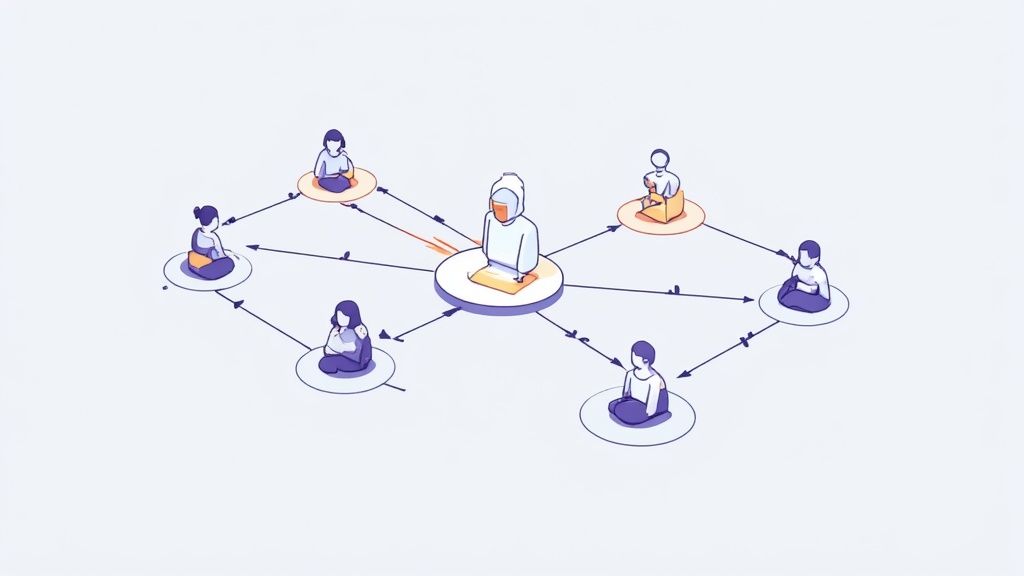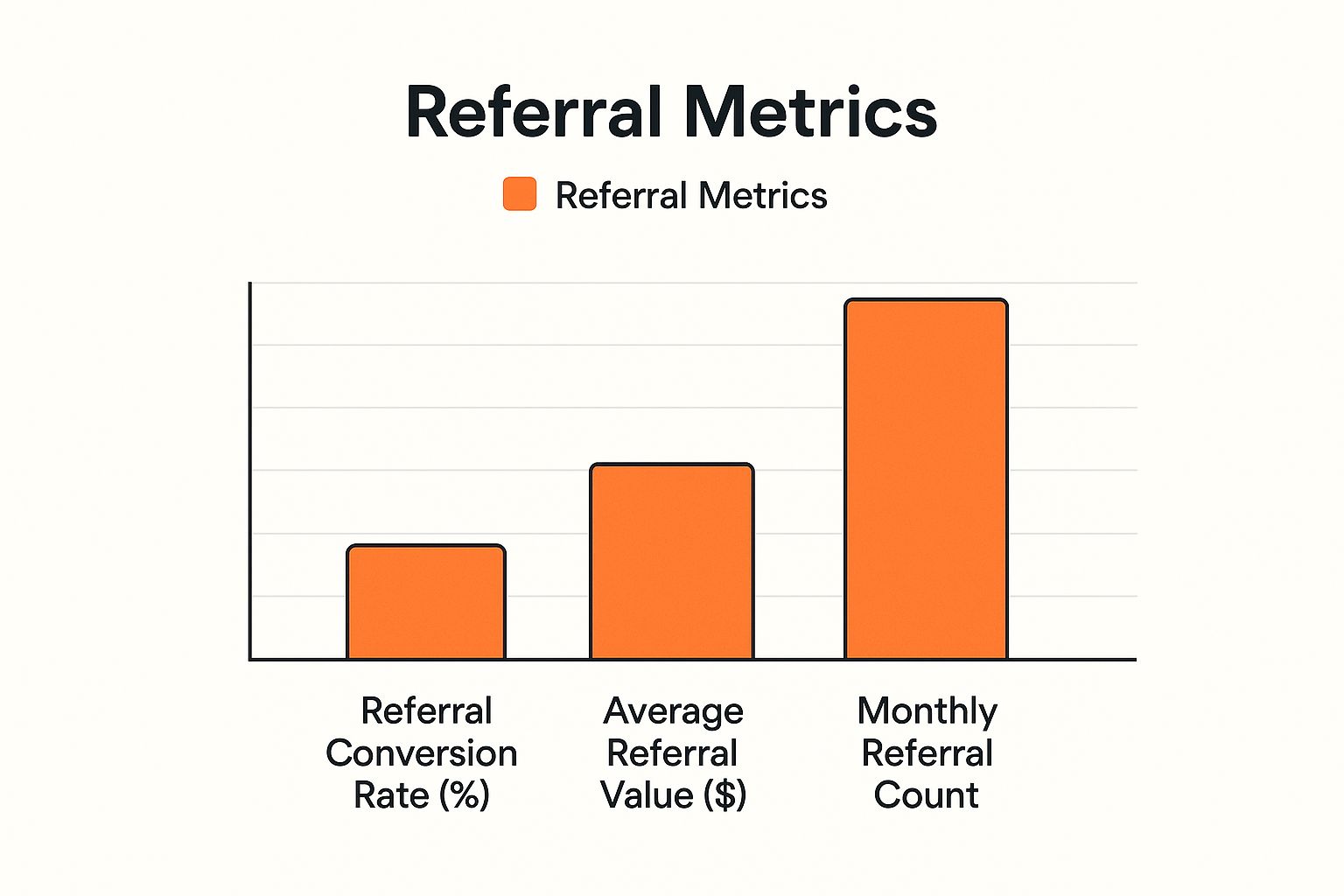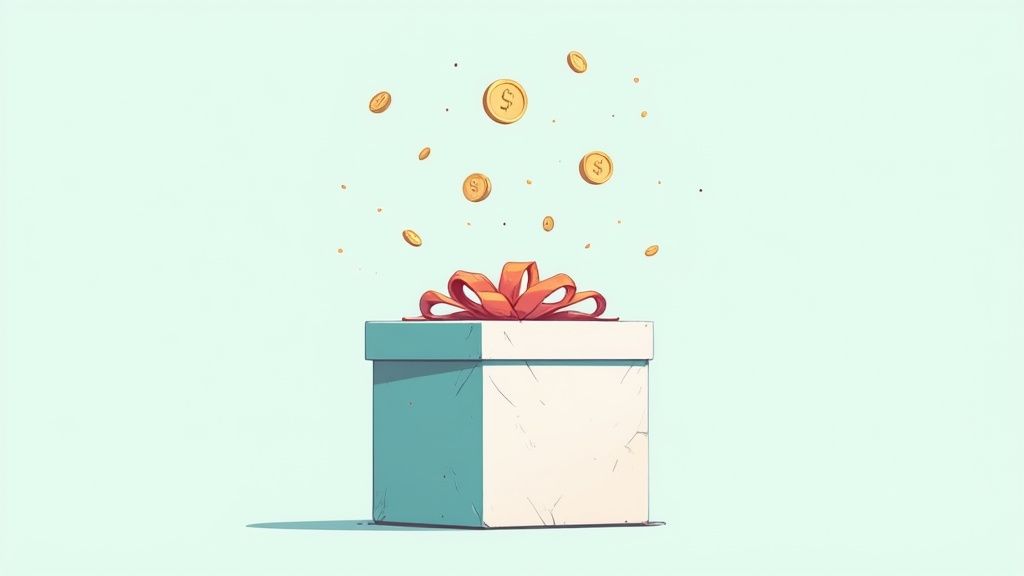Build a Good Referral Program That Drives Growth
A good referral program is a system that turns your happiest customers into your best marketers. It's more than just slapping a discount on a link; think of it as a "word-of-mouth amplifier" that channels genuine enthusiasm into real growth. The best programs are a breeze for customers to use, genuinely rewarding for both the person sharing and their friend, and simple for the business to track.
What Makes a Good Referral Program Work

At its heart, a great referral program runs on a simple, powerful human principle: trust.
Think about it. When you need a recommendation for a new restaurant or a reliable contractor, who do you ask first? Your friends and family. A referral program just takes this natural, everyday behavior and gives it a little structure, turning it into a predictable growth channel for your business. It’s a way to systematically encourage your most loyal customers to spread the word to people who already trust them.
This isn’t just a feel-good idea; the numbers back it up in a big way. An incredible 92% of consumers trust recommendations from people they know far more than any other form of advertising. This trust directly impacts the bottom line. Businesses that lean into formal referral programs often see a 71% higher conversion rate, and the customers they bring in tend to have a 25% higher lifetime value.
The Psychology of Sharing
A successful program gets what makes people tick. It's not always about the cash or the discount. Many times, your customers share for much deeper reasons:
- They genuinely want to help their friends. Sharing an awesome product or service feels good because you're giving value to someone you care about.
- They feel a real connection to your brand. Your most passionate customers become advocates because they want to see a brand they love succeed and grow.
- It boosts their social standing. Being the person with the inside scoop on a cool new thing is a form of social currency.
To give you a clearer picture, I've put together a table that breaks down the essential ingredients of a program that people actually want to use.
Key Characteristics of a Successful Referral Program
| Characteristic | Why It Matters | Impact |
|---|---|---|
| Simple to Understand | If it takes more than 10 seconds to explain, people won't bother. | Higher participation rates and less confusion for users. |
| Easy to Share | One-click sharing links, pre-written messages, and multiple platform options are key. | Removes friction, making it effortless for advocates to spread the word. |
| Mutually Beneficial | Rewarding both the referrer and the new customer creates a win-win scenario. | Motivates the friend to sign up and thanks the advocate for their effort. |
| Trust-Driven | The program should feel like a genuine recommendation, not a sales pitch. | Maintains authenticity and leverages the power of social proof. |
| Easy to Track | Advocates need to see their progress and rewards clearly in a simple dashboard. | Builds confidence in the program and encourages continued participation. |
Ultimately, a well-designed program builds on these core pillars to create an experience that feels natural and valuable, not forced.
While we're focused on customer-to-customer referrals here, it's also helpful to know how this model compares to others. For instance, understanding the intricacies of an affiliate program can provide useful context, as they operate on similar principles but often involve different types of advocates and reward structures.
Your goal is to build a system that feels less like a marketing campaign and more like a community of fans sharing something they truly believe in. That’s the real secret to unlocking sustainable growth driven by the people who already love you.
Designing the Core of Your Referral Engine

Alright, let's move from theory to practice and start building the mechanics of your program. A great referral program feels almost magical to your customers, but it doesn't happen by chance. It’s a carefully engineered experience. Think of it like building a high-performance engine—every single component needs to work in perfect harmony to generate serious momentum.
Your success will hinge on four key pillars: an offer that benefits everyone, messaging that's impossible to misunderstand, a sharing process that’s dead simple, and tracking that’s completely transparent. Nail these four elements, and you’ll turn happy customers into your most powerful growth channel.
Crafting an Irresistible Two-Sided Offer
The incentive is the absolute heart of your referral program. The best programs aren't just about rewarding the referrer; they create a win-win-win. Your customer wins, their friend wins, and your business wins. This mutual value is what makes the whole thing feel like a genuine recommendation, not a sales pitch.
While cash is a common reward, don't overlook the power of non-cash incentives. One study actually found they can be 24% more effective at motivating people. Why? Because they tie the reward directly back to your brand and encourage future purchases.
Here are a few high-impact, non-cash ideas to get you started:
- Store Credit or Discounts: A classic "Give 20%, Get 20%" model is brilliant because it encourages both people to shop with you, driving immediate sales.
- Tiered Milestone Rewards: Take a page from Harry’s legendary pre-launch campaign. Offer increasingly valuable rewards as advocates hit referral milestones, like free products or early access to new items.
- Loyalty Points or Freebies: For a loyal customer, getting a free bag of their favorite coffee or bonus loyalty points can feel far more special and personal than a few dollars.
The goal is to offer something of real value that keeps people coming back. It’s less about a one-time transaction and more about strengthening that customer relationship for the long haul.
Ensuring a Frictionless and Transparent Experience
If your referral process is confusing or complicated, it's dead on arrival. People are busy. If they have to hunt for their referral link or can't figure out if they’ve earned a reward, they’ll simply give up. Simplicity is everything.
This means giving them one-click sharing options, pre-written (but editable!) messages, and a clean, simple dashboard to see their progress in real-time. This transparency is crucial for building trust and keeping them motivated. When you're putting together the technical side of your referral engine, it’s worth looking into specialized platforms like Domino Referrals that handle all the complex bits for you.
With a platform like Toki, you can build this entire engine without the headache. Toki lets you create and automate the perfect two-sided offer, whether you're giving out points, discounts, or exclusive perks. It also gives your advocates a simple, branded portal to track every referral and reward, making sure the entire experience is seamless and clear from start to finish.
Calculating the Real ROI of Your Referral Program
A great referral program feels good, but it should also make serious financial sense. To really see what your program is worth, you have to look past simple numbers like shares and clicks and get down to the metrics that truly matter: Return on Investment (ROI) and Customer Acquisition Cost (CAC). This is where referral marketing pulls away from the pack, especially when compared to expensive channels like paid ads.
Think about it this way: when you run digital ads, you're essentially renting an audience's attention for a short time. A referral program, on the other hand, helps you build a lasting asset. It’s a sustainable, low-cost way to bring in new customers that’s powered by genuine trust. The best part? These referred customers aren't just cheaper to acquire; they often stick around longer and spend more, making them incredibly valuable to your business.
Moving Beyond Vanity Metrics
It’s easy to get excited when you see referral links flying around social media, but that’s not the whole story. The real proof is in the bottom line. Smart brands know this and justify their referral programs by tracking the long-term value and pure cost-effectiveness of this channel.
The data backs this up time and time again. Research from big names like Harvard Business Review, Forrester, and Deloitte shows that referral programs can deliver a stunning 312% higher ROI over three years. At the same time, they can slash customer acquisition costs by up to 35% compared to other marketing channels.
This image highlights some of the key numbers you should be watching.

As you can see, a successful program isn't just about the volume of referrals. It's about bringing in high-value customers and achieving impressive conversion rates along the way.
To put the financial power of referrals into perspective, let's compare it directly to other common marketing channels.
Referral Marketing ROI vs. Other Channels
| Marketing Channel | Average ROI | Typical CAC | Lead Quality |
|---|---|---|---|
| Referral Marketing | 16:1 or higher | Lowest | Very High |
| SEO | 10:1 | Low to Medium | High |
| Email Marketing | 42:1 (with existing list) | Low | Varies |
| Paid Search (PPC) | 2:1 | High | Medium |
| Social Media Ads | 3:1 | High | Low to Medium |
As the table shows, referral marketing consistently offers one of the best returns for your investment. The combination of extremely low acquisition costs and high-quality leads is a powerful one-two punch that other channels struggle to match.
A Framework for Measuring Real Impact
So, how can you track this for your own program? To build a solid, data-backed case, you need to focus on a few core metrics:
- Customer Acquisition Cost (CAC): This one is simple. Divide your total program costs (rewards, software fees, etc.) by the number of new customers you gained through referrals. Now, put that number next to the CAC from your paid search or social media campaigns. The difference is often eye-opening.
- Customer Lifetime Value (LTV): Start tracking the spending of referred customers versus non-referred ones over six to twelve months. You'll likely discover that referred customers spend more and have a significantly higher LTV, which is a massive piece of the ROI puzzle.
- Conversion Rate: Keep a close eye on the percentage of referred friends who actually follow through and become paying customers. A strong conversion rate is one of the clearest signs of a healthy, well-designed program.
By focusing on these outcomes, you change the internal conversation from, "How many people are sharing?" to, "How much real value is our program generating?" That kind of financial clarity is what gets you the budget and buy-in to scale your efforts.
Building a complete referral marketing strategy absolutely depends on this level of detailed tracking. A platform like Toki gives you an analytics dashboard that makes monitoring these KPIs straightforward. It automatically calculates your ROI, CAC, and LTV, giving you the clear, data-driven insights you need to prove your program's worth and fine-tune it for even better results.
Good Referral Programs That Became Legendary
 Theory is helpful, but seeing a great referral program in the wild is where the real learning happens. Some companies have built programs so effective they’ve become legendary—not just for boosting sales, but for building entire empires. These campaigns weren't just about handing out a simple discount; they were masterful lessons in human psychology, perfect timing, and seamless execution.
Theory is helpful, but seeing a great referral program in the wild is where the real learning happens. Some companies have built programs so effective they’ve become legendary—not just for boosting sales, but for building entire empires. These campaigns weren't just about handing out a simple discount; they were masterful lessons in human psychology, perfect timing, and seamless execution.
When we break down how these brands created such explosive growth, we can pull out key strategies to use in our own businesses. It’s all about seeing what the best have done and figuring out how to build a program that doesn't just work, but becomes a core part of your own growth story. Let's look at how a well-designed referral system can become your most powerful marketing tool.
Harry's Viral Pre-Launch Campaign
Before Harry's even sold its first razor, it whipped up a massive wave of excitement with a truly brilliant pre-launch referral campaign. Instead of a basic "give one, get one" deal, they gamified the entire process with a tiered milestone system, which created an incredible sense of anticipation and friendly competition.
The idea was simple but executed perfectly. People would land on a pre-launch page, enter their email, and get a unique referral link. The more friends they got to sign up with that link, the bigger and better the prize they unlocked.
- 5 Referrals: Free shave cream
- 10 Referrals: Free razor handle with a blade
- 25 Referrals: Free premium razor
- 50 Referrals: A full year of free blades
This strategy was pure genius. It gave advocates a clear, escalating incentive to keep sharing. And the results speak for themselves. Historical case studies show Harry's gathered around 100,000 email addresses in just one week.
SmartBear's Data-Driven Advocacy
The software company SmartBear took a different, but just as powerful, route. They didn't aim for a massive, broad campaign. Instead, they dove into their data to find their most enthusiastic users and systematically turned them into a hyper-effective referral force. The secret was identifying and approaching these advocates at the perfect moment.
How did they do it? They simply integrated their referral program directly into their customer satisfaction surveys. Any customer who left a high rating was immediately invited to join the referral program. This one small step ensured they were only asking their happiest, most loyal users to become brand advocates.
The lesson here is profound: a good referral program doesn't just ask everyone. It asks the right people at the right time.
This targeted method delivered incredible results. SmartBear saw its referral-driven close rate climb from 30% to 47%, and the program brought in over $6 million in revenue. It's a powerful reminder that your best advocates are usually already there—you just need to use data to find them.
Both of these legendary campaigns offer some fantastic takeaways. To see how other companies have found success, check out our guide on more referral marketing examples that break down different strategies across various industries.
This is exactly the kind of sophisticated strategy you can set up with a tool like Toki. You can easily create tiered milestone rewards like Harry's to make sharing fun. You can also automatically trigger referral invites based on customer actions, like a positive review, helping you activate your happiest customers just like SmartBear did.
Launching and Managing Your Program for Success
Building a referral program is one thing; getting it off the ground and running smoothly is another entirely. You can have the most beautifully designed program in the world, but the real magic happens when you launch it and put it in front of your customers. This is the moment your hard work starts paying off and turns into a real engine for growth.
Your launch doesn't have to be some massive, complicated production. The main goal is simple: get your program in front of your most enthusiastic customers without being disruptive. Start by weaving promotions into the places they already visit. Think about adding a banner to their account dashboard, including a friendly mention in your email newsletter, or even showing a small prompt right after they complete a purchase.
Promoting Your Program Effectively
Once your program is live, you can't just expect people to find it. Consistent promotion is what keeps the momentum going. It's less like a one-off firework show and more like a steady, rhythmic drumbeat.
Here are a few proven ways to keep your program on your customers' radar:
- Email Campaigns: Kick things off with a dedicated email blast announcing the new program. After that, keep the reminder alive by adding a small blurb to the footer of your transactional emails—things like order confirmations and shipping notices are perfect for this.
- In-App and On-Site Prompts: Use smart, subtle prompts inside your app or on your website. The absolute best time to ask for a referral is right after a customer has had a great experience, like leaving a 5-star review or making their second or third purchase.
- Social Media Channels: Post about your referral program regularly on your social media accounts. Create clean, simple graphics that clearly explain the offer (what the giver gets, and what the receiver gets). Make it easy to understand in a single glance.
The best promotion doesn't feel like an ad. It feels like a helpful nudge, a reminder of a great opportunity waiting for them. It’s all about being there at the right time, not shouting the loudest.
Monitoring and Optimizing for Growth
A referral program isn’t something you can just set up and walk away from. To get the best results, you need to keep a close eye on its performance and be willing to tweak things along the way. Get familiar with your key performance indicators (KPIs), like your participation rate (how many customers join), share rate (how many actually share their link), and the conversion rate of the friends they refer.
This data tells you exactly where you can improve. Is the reward not quite hitting the mark? Try A/B testing a different incentive. You could pit a “Give $20, Get $20” offer against a “Give 20%, Get 20%” discount to see what your customers respond to. Small changes to headlines or calls-to-action in your promos can also make a huge difference.
This is where a tool like Toki really shines. You can manage the entire process from start to finish. Launch your program using customizable promotional tools, and then head straight to the analytics dashboard to track your most important KPIs in real time. Toki’s built-in A/B testing features make it easy to experiment with different offers and messaging, so you can be sure your program is always getting better and driving the best possible return.
Common Mistakes That Will Derail Your Referral Program
Even a referral program with the best of intentions can fall flat if it runs into a few common traps. Honestly, designing a great program is as much about knowing what not to do as it is about what you should do. If you ignore these pitfalls, you're looking at low engagement, frustrated customers, and a campaign that fizzles out before it ever gets going.
Think of it like building a bridge. You can have the strongest steel and the best design, but if a few key supports are weak, the whole thing is compromised. Your referral program works the same way. Just one or two points of serious friction can be enough to stop your customers from ever sharing.
The most common and damaging mistake? Creating a complicated sharing process. If a customer has to hunt for their referral link, copy and paste a long, clunky code, or navigate a maze of pages, they just won't do it. People are busy, and the slightest hassle is enough to extinguish their enthusiasm.
Asking at the Wrong Time
Another critical error is simply bad timing. Asking for a referral is a delicate dance, and it all comes down to how your customer is feeling in that exact moment. Blasting out a generic "refer a friend" email to your entire list is a waste of time and can feel pretty impersonal.
The best time to ask for a referral is immediately following a moment of delight. This could be right after a customer leaves a 5-star review, makes a repeat purchase, or gives you a high Net Promoter Score (NPS).
When you ask at their peak happiness, you're tapping into that positive energy when they are most excited to share their experience.
Other common mistakes that can sink your efforts include:
- Underwhelming or One-Sided Rewards: The incentive has to feel valuable to both the person sharing and their friend. An offer like "Give 20%, Get $5" can feel lopsided and isn't very motivating for the original customer.
- A Lack of Transparency: Customers need to know what's happening. If they send a friend your way and then hear nothing but crickets, they'll lose trust and stop bothering to participate. A simple status tracker makes all the difference.
- Not Promoting the Program: You can build the world's greatest referral program, but it won't do you any good if nobody knows it exists. You have to promote it consistently without being obnoxious.
Steering clear of these missteps is just as crucial as implementing the right strategies. For a deeper look at what to focus on, check out our guide on referral program best practices to make sure your program is set up for success from day one.
Got Questions About Referral Programs? We've Got Answers.
Even with a solid plan, a few questions are bound to pop up. Let's tackle some of the most common ones that come up when you're putting together a referral program.
What’s the Best Incentive to Offer?
Honestly, the best incentive is whatever your customers find genuinely valuable and feels right for your brand. While cash is always an option, one study found that non-cash incentives can be 24% more effective. Why? Because they tie the reward directly back to your brand and products, encouraging more engagement.
A two-sided reward, where both the person referring and their friend get something, is usually the gold standard. It just feels fairer and more compelling. Think about offering things like:
- Store Credit: A classic "Give $20, Get $20" deal is a win-win, driving both parties to make a purchase.
- A Free Month of Service: Perfect for subscription models, this constantly reminds customers of your product's value.
- Exclusive Access: Offering early access to new features or limited-edition products can create a powerful sense of being a VIP.
Ultimately, the secret is to experiment. Test a few different offers and see what your audience actually gets excited about while still giving you a healthy return.
When's the Right Time to Ask for a Referral?
Timing is everything. You want to ask for a referral right after a customer has had a fantastic experience. That’s when their excitement is at its peak and they're most likely to shout your praises from the rooftops.
Focus on these "moments of delight" to dramatically increase the likelihood they'll share. Key opportunities include right after a customer leaves a positive review, makes a repeat purchase, or gives you a high Net Promoter Score (NPS).
Catch them when they’re already happy with you, and asking them to share feels like a natural next step, not a chore.
How Do I Know If My Program Is Actually Working?
To get a true sense of your program's impact, you need to track a few key metrics. The most important ones are your Participation Rate (how many people sign up), Share Rate (how many of those people actually send referrals), and Conversion Rate (how many of those referrals turn into new customers).
By keeping an eye on these numbers, along with your program’s overall ROI and Customer Acquisition Cost (CAC), you'll get a crystal-clear picture of what's working and where you can make improvements.
Building a loyalty and referral program that customers love is simple with Toki. You can automate rewards, see your ROI on a powerful analytics dashboard, and turn your best customers into your most effective marketers. Get started with Toki today!